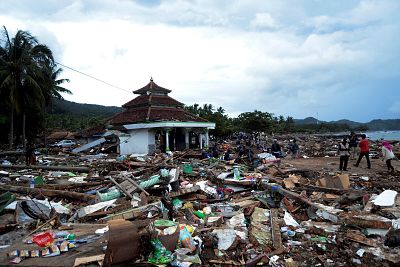"This was not a common tsunami," said Costas Synolakis, director of USC's Tsunami Research Center. "This was a volcanic tsunami."
A tsunami that devastated the area around Indonesia's Sunda Strait, leaving at least 222 dead and hundreds more injured, struck fast and without warning on Saturday.
While most tsunamis have seismic precursors that allow for some form of warning, an unfortunate chain of factors led to Saturday's catastrophic impact, experts say.
The tsunami, which happened between Java and Sumatra islands, was caused by the Anak Krakatau, an active volcano that has been erupting since June.
Two theories have emerged about what caused the eruption: Either an underwater landslide or a spewing of molten lava caused the displacement. Experts say it is more likely that the wave was triggered by a landslide.
"This was not a common tsunami," said Costas Synolakis, director of the University of Southern California's Tsunami Research Center. "This was a volcanic tsunami ... it did not rise to the level of triggering an alert. So from that point of view, the Tsunami Warning Centers were essentially useless."
Because of Anak Krakatau's proximity to shore, Saturday's tsunami likely struck 20 to 30 minutes after some sort of volcanic activity, according to Synolakis.
"A volcano is something that is a living thing. This is something that geologically is not in a steady state at any time," said Emile Okal, professor emeritus of earth science at Northwestern University, who has studied tsunamis for 35 years. "Eventually it's going to have a landslide, and if it's underwater, going to displace water and make a wave."
Okal said in order to properly detect the tsunami, Indonesia would need to spend approximately a billion dollars on technology and round-the-clock manpower along its coast — and even then it's not a guarantee that a warning would come in time.
But the fact that the tsunami was caused by a volcano and not an earthquake was not the only reason it was so lethal.
"It's bad that this occurred at night ... apparently, to add insult to injury, this occurred during high tide. Everything being equal, the hazard will be increased," Okal said.
As the tsunami struck, it swept away concertgoers watching the Indonesian pop band Seventeen, who were performing under a tent on a popular beach.
The band released a statement saying their bass player and road manager were found dead, while three other band members and the wife of one of the performers remained missing.
"It's not a good idea to have rock concert on the beach in the vicinity of an erupting volcano," Okal said. "That is a comment that is easy to make after the fact but is nevertheless something which comes out of common sense."
This is not the first time Anak Krakatau has caused damage to Indonesia, according to Synolakis. In 1883, the volcano devastated the same region during a time of volcanic activity.
News
"It's not expected but not unexpected for an eruption to take place that could create avalanche in same way that was triggered 175 years ago," he said.
Gegar Prasetya, co-founder of the Tsunami Research Center Indonesia, said despite the devastation, this was far from one of Indonesia's biggest. In September, more than 2,500 people were killed by a quake and tsunami that hit the city of Palu on the island of Sulawesi, which is just east of Borneo.
"Actually, the tsunami was not really big, only one meter," said Prasetya, who has closely studied Anak Krakatau. "The problem is people always tend to build everything close to the shoreline."
Synolakis said it's unrealistic to expect everyone to leave the coasts, but added that those who are in high risk areas should be aware of the serious potential for a catastrophe — a point Okal echoed.
"If you're at the beach — which you should be at, enjoy the beach — but if you see anything anomalous, shaking or strange behavior, just run away," Okal said.












